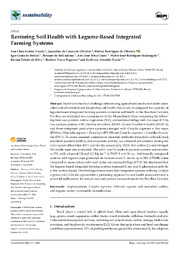Restoring soil health with legume-based integrated farming systems.
Restoring soil health with legume-based integrated farming systems.
Author(s): DUARTE, A. C. S.; OLIVEIRA, J. de C. de; OLIVEIRA, W. R. de; FREITAS, I. C. de; CARDOSO, A. S.; COUTO, A. J. S.; MATRANGOLO, W. J. R.; SILVA, K. T. da; PEGORARO, R. F.; FRAZÃO, L. A.
Summary: Faced with the dual challenge of increasing agricultural production (both intensified and diversified) and improving soil health, this study investigated the capacity of legume-based integrated farming systems to restore soil health in the Brazilian Cerrado. For that, we evaluated two experiments in the Minas Gerais State comparing the following land use systems: native vegetation (NV), conventional tillage with Zea mays (CT-8), two pasture systems with Urochloa decumbens (PAST-13) and Urochloa brizantha (PAST-1), and three integrated production systems arranged with Cratylia argentea + Zea mays (IPS-8A), Gliricidia sepium + Zea mays (IPS-8B) and Cratylia argentea + Urochloa brizantha (IPS-1). To assess seasonal variations in microbial attributes (microbial carbon [Cmic], microbial quotient (qMIC), and enzymatic activity, we collected soil samples during the rainy season (December 2021) and the dry season (July 2022). Soil carbon (C) and nitrogen (N) stocks were also evaluated. The soil C and N stocks in pasture systems were similar to VN, with values of 120 and 8.2 Mg ha?1 in PAST-1 at 0–30 cm. Additionally, integrated systems with legume crops promoted an increase in soil C stocks up to 24% (IPS-8B) when compared to monoculture cultivated under conventional tillage (CT-8). We also found that the legume-based integrated farming systems increased Cmic and ?-glucosidase activity at the surface layers. Our findings demonstrate that integrated systems utilizing Cratylia argentea and Gliricidia sepium offer a promising approach to soil health restoration and a potential replacement for annual crop and pasture monocultures in the Brazilian Cerrado.
Publication year: 2025
Types of publication: Journal article
Unit: Embrapa Maize & Sorghum
Observation
Some of Embrapa's publications are published as ePub files. To read them, use or download one of the following free software options to your computer or mobile device. Android: Google Play Books; IOS: iBooks; Windows and Linux: Calibre.
Access other publications
Access the Agricultural Research Database (BDPA) to consult Embrapa's full library collection and records.
Visit Embrapa Bookstore to purchase books and other publications sold by Embrapa.

